
1432523
26.11.2018
Banco sega per legno
ISTRUZIONI PER L’USO E ISTRUZIONI DI SICUREZZA
Istruzioni originali
Saw bench for wood
INSTRUCTION MANUAL AND SAFETY INSTRUCTIONS
Translation of the original instructions
ATTENZIONE! Prima di usare la macchina, leggete attentamente le istruzioni
CAUTION! Before starting the machine, read the instructions carefully
BSC2316

- 2 -
VALEX-36015SCHIO (VI) -ITALY
MADEINP.R.C.
85632111
9
9
74 10
12 10 11 4 5 6 7 8 9
1
3
2

- 3 -
VALEX-36015SCHIO (VI) -ITALY
MADEINP.R.C.
85632111
9
9
74 10
12 10 11 4 5 6 7 8 9
1
3
2

- 4 -

- 5 -

- 6 -
- Lancio di materiale e polvere verso gli occhi ed il corpo dell’ope-
ratore. Indossate occhiali di protezione e maschera antipolvere.
- Material and dust flying towards the operator’s eyes and body.
Use eye protection and an anti-dust mask.
- Rumore elevato generato dalla macchina. Indossate cuffie a pro-
tezione dell’udito.
- Loud noise generated by the machine. Use ear protection.
- Rischio di scossa elettrica con pericolo di morte. Non toccate le
parti in tensione elettrica e mantenete una distanza di sicurezza.
Prima di ogni manutenzione scollegate la spina dalla presa di
alimentazione.
- Risk of electric shock and danger of death. Do not touch the elec-
trically live parts and keep a safe distance. Before any maintenance
operations, unplug the machine from the power supply.
RISCHI RESIDUI
RESIDUAL RISKS
Queste illustrazioni mostrano i rischi residui nell’uso della macchina. Leggete attentamente il libretto istruzioni della macchina.
These illustrations show the main risks involved with using the machine. Read the machine instruction manual carefully.
- Lama, spigoli e schegge di legno che provocano ferite alle mani.
Indossate guanti protettivi e mantenete una distanza di sicurezza
dalla zona di taglio. Non tentate di togliere residui di sporco o
materiali di lavorazione inceppati finchè la lama ruota.
- Blade and sharp edge and burrs which could cut hands. Wear
protective gloves and keep a safe distanc e from the cutting area.
Do not attempt to remove dirt or jammed work materials until the
blade rotates.

- 7 -

- 8 -
i
Vi ringraziamo per averci preferito nella scelta di questo prodotto di
seguito chiamato anche ‘macchina’ o ‘utensile’.
ATTENZIONE! Prima di usare questo macchina, leggete ed applicate
attentamente le norme di sicurezza e le istruzioni di seguito ripor-
tate. Prima di iniziare il lavoro assicuratevi, in caso di emergenza,
di saper arrestare la macchina. L’uso improprio della macchina
può provocare gravi ferite.
Conservate con cura ed a portata di mano queste istruzioni in modo
da poterle consultare in caso di necessità.
ll banco sega è idoneo per eseguire il taglio di legno. Ogni altro
impiego, diverso da quello indicato in queste istruzioni può recare
danno all’utensile e costituire serio pericolo per l’utilizzatore.
ATTENZIONE! Esclusivamente per uso hobbistico.
ATTENZIONE! Non utilizzare la macchina in ambienti umidi, con
pioggia o nebbia.
DESCRIZIONE (FIG. A)
1 Piano di lavoro
2 Lama
3 Protezione lama
4 Attacco per aspiratore
5 Guida parallela
6 Squadra orientabile
7 Manovella regolazione altezza lama
8 Interruttore
9 Maniglie per trasporto
10 Ruote
11 Tubo aspirazione
DESCRIZIONE MARCATURE E SIMBOLI (FIG. B)
1 Modello macchina e dati tecnici.
2 Codice macchina, numero di matricola o numero lotto, anno di
fabbricazione, marchi di certificazione (se presenti).
3 I rifiuti elettrici ed elettronici possono contenere sostanze pericolose
per l’ambiente e la salute umana; non devono pertanto essere
smaltiti con quelli domestici ma mediante una raccolta separata
negli appositi centri di raccolta o riconsegnati al venditore nel caso
di una apparecchiatura nuova analoga. Lo smaltimento abusivo
dei rifiuti comporta l’applicazione di sanzioni amministrative.
4 ATTENZIONE!
5 Leggete attentamente le istruzioni prima dell’uso.
6 Attenzione! Pericolo taglio e schiacciamento mani. E’ obbliga-
torio indossare guanti di protezione.
7 Attenzione! Pericolo lancio materiale e polveri dannose. E’
obbligatorio indossare occhiali di protezione e una maschera
a difesa delle vie respiratorie.
8 Attenzione! Pericolo rumore elevato. E’ obbligatorio indossare
cuffie a difesa dell’udito.
9 Attenzione! Pericolo di scossa elettrica. Alcune parti della
macchina sono in tensione elettrica, non toccatele e mantenete
una distanza di sicurezza.
10 Attenzione! Pericolo di taglio ed impigliamento. Mantenete le
mani lontano dalla lama.
11 Attenzione! Prima di ogni controllo, regolazione o manuten-
zione, staccate l’alimentazione elettrica scollegando la spina
della macchina. In caso di cavo di alimentazione danneggiato,
estraete la spina dalla presa della rete di alimentazione prima
di procedere ad un controllo.
12 Livello emissione sonora.
CARATTERISTICHE
- Possibilità di taglio inclinato.
- Profondità di taglio variabile.
- Attacco aspirazione polveri superiore e inferiore.
- Possibilità di spostamenti tramite ruote.
DOTAZIONE
La confezione di acquisto comprende:
- Banco sega
- Lama
- Protezione lama
- Guida parallela
- Squadra guidapezzo orientabile
- Spingipezzo
- Viteria
- Manuale di uso e manutenzione (questo manuale)
- Certificato di garanzia (annesso al presente manuale)
- Certificato di conformità (annesso al presente manuale)
DATI TECNICI
Tensione e frequenza nominale _________________ 230V~50Hz
Potenza nominale assorbita _______________________ 2000 W
Tipo di servizio ____________________________ S6 20% 5min
Giri nominali ______________________________ n0 2800 min-1
Diametro lama di taglio __________________________ 315 mm
Diametro foro lama ______________________________ 30 mm
Spessore taglio _________________________________3,6 mm
Profondità di taglio max __________________________ 83 mm
Pressione acustica ___________________ LpA 92,6 dB(A) K=3
Potenza acustica _____________________LwA103,5 dB(A) K=3
NORME DI SICUREZZA GENERALI
1) E’ vietato l’uso della macchina ai bambini e persone inesperte.
2) Controllate sempre l’efficienza e l’integrità della macchina; può
causare pericolo per chi la usa.
3) Allontanate dal raggio di lavoro cose, persone ed animali e non
lasciate che queste si avvicinino mentre state lavorando. Non
utilizzate la macchina senza i dispositivi di sicurezza correttamente
montati.
4) Non avviate la macchina in luoghi chiusi o poco ventilati ed in
presenza di liquidi, polveri, gas ed altri elementi infiammabili e/o
esplosivi.
5) Utilizzate un utensile di potenza adeguata al lavoro da svolge re,
evitando inutili sovraccarichi rischiosi per l’operatore e per la durata
dell’utensile stesso.
6) Non togliete mai nessun componente della macchina e non mo-
dificatela in alcun modo.
7) Non afferrate mai la macchina per l’utensile da taglio.
8) Verificate sempre il corretto fissaggio della lama prima di utilizzare
la macchina.
9) Prima di utilizzare la macchina, accertatevi che eventuali chiavi di
servizio siano state tolte.
10) Nella zona di lavoro, l’operatore é responsabile verso terzi.
11) Raccogliete i capelli lunghi e non indossate bracciali o catenine
lunghe perché potrebbero intrappolarsi nelle parti mobili della
macchina.
12) Durante il lavoro indossate sempre un abbigliamento adeguato.
Usate pertanto occhiali e guanti protettivi adeguati. Gli occhiali
da vista non sostituiscono quelli protettivi specifici. Nel caso la
lavorazione produca polvere, utilizzate le apposite mascherine di
protezione.
ATTENZIONE! Le protezioni personali sono essenziali per la vostra
sicurezza e per una corretta prevenzione sanitaria. Il mancato ri-
spetto di tale norma può creare seri problemi alla vostra integrità
fisica.
13) Non toccate mai le parti in movimento della macchina.
14) Spegnete il motore e staccate la spina della macchina dalla presa
di alimentazione quando: non la usate, la lasciate incustodita, la
controllate, il cavo di alimentazione è danneggiato, sostituite la
lama, la trasportate da un posto all’altro, la pulite.
ATTENZIONE! Prima di pulire la macchina da residui di lavorazione,
staccate sempre la spina.
15) Tenete sempre il luogo di lavoro pulito e libero da intralci.
16) Durante il lavoro non distogliete mai l’attenzione da ciò che state
facendo.

- 9 -
17) Lavorate solo nelle ore di buona luminosità o con una illuminazione
artificiale corrispondente.
18) Prima di inserire la spina nella presa di corrente, accertatevi che
l’interruttore sia nella posizione di spento.
19) Per fermare la macchina agite sempre e solo sull’ interruttore.
20) Utilizzate la macchina solo nei modi descritti in queste istruzioni.
21) Quando non la usate, riponete la macchina in un luogo asciutto e
lontano dalla portata dei bambini.
22) Verificate periodicamente il fissaggio delle viti.
23) Collegate sempre la macchina ad un impianto di aspirazione polveri.
24) Verificate periodicamente che le feritoie di raffreddamento del
motore siano completamente aperte e pulite.
25) POLVERI DANNOSE ALLA SALUTE
ATTENZIONE! Le polveri di alcuni tipi di legno sono molto dannose
alla salute. Indossate le protezioni alle vie respiratorie, aspirate
i trucioli dalla macchina e dotate il locale di un estrattore per il
ricambio dell’aria.
NORME DI SICUREZZA ELETTRICHE
1) La tensione di alimentazione deve corrispondere a quella dichia-
rata sulla targhetta dati tecnici. Non utilizzate nessun altro tipo di
alimentazione.
2) E’ consigliato l’uso di un apparecchio salvavita sulla linea di
alimentazione elettrica. Consultate il vostro elettricista di fiducia.
3) Non usate la macchina in ambienti o superfici umide o bagnate e
non esponetela alla pioggia.
4) ll cavo di alimentazione deve essere controllato periodicamente e
prima di ogni uso per vedere se presenta segni di danneggia mento
o di invecchiamento. Se non risultasse in buone condizioni non
usate la macchina ma fatela riparare presso un centro di assistenza
autorizzato.
5) Se usate una prolunga con avvolgicavo, srotolate completamente
il cavo altri menti potrebbe surriscaldarsi e incendiarsi.
6) Se usate un cavo di prolunga, assicuratevi che sia del tipo omo-
logato. Tenetelo lontano dalla zona di lavoro, da superfici umide,
bagnate, oliate, con bordi taglienti, da fonti di calore e da combu-
stibili.
7) La presa di alimentazione deve essere del tipo bipolare con messa
a terra 10-16A/250V . La sezione del filo deve essere uguale o
superiore ad 1 mm2. Usate cavo armonizzato non più leggero del
tipo H05VV-F.
8) Quando scollegate il cavo di alimentazione dalla presa di corrente,
afferratelo sempre per la spina.
MESSA IN SERVIZIO (FIG. A-C)
ATTENZIONE! La Ditta Costruttrice declina ogni responsabilità per
gli eventuali danni diretti e/o indiretti causati da errate installazioni
e allacciamenti.
ATTENZIONE! Prima di effettuare le seguenti operazioni assicuratevi
che la spina della macchina sia scollegata dalla rete elettrica.
La macchina è fornita con alcuni componenti smontati e prima di
usarla deve essere pulita ed installata.
Nella scelta della posizione della macchina è opportuno considerare:
- che la posizione prevista non sia umida e sia al riparo dagli agenti
atmosferici.
- che la zona di appoggio risulti perfettamente in piano, su di un pavi-
mento antisdrucciolo e con una capacità di carico adeguata.
- che attorno alla macchina sia prevista un’ampia zona operativa libera
da impedimenti.
- che il locale sia custodito e chiuso per impedire il libero accesso.
- che vi sia una buona illuminazione.
- che sia posizionata in vicinanza dell’interruttore generale con diffe-
renziale.
- che l’impianto di alimentazione sia dotato di messa a terra conforme
alle norme.
- che la temperatura ambiente sia compresa tra 10° e 35° C.
- che l’ambiente di lavoro non sia in atmosfera esplosiva.
Togliete la parte superiore dell’imballo e verificate visivamente la
perfetta integrità della macchina e dei componenti; a questo punto
eliminate l’imballo e procedete ad una accurata pulizia per togliere gli
eventuali oli protettivi utilizzati per il trasporto.
- Montate le gambe (Fig.C1 pos.1) al piano di lavoro, e il dispositivo
di prolungamento (Fig.C2 pos.2),avendo cura che la gamba con
l’alloggio interruttore sia montata come in Fig.A (gamba sinistra verso
alimentazione pezzo), inserendo e fissando con i dadi solamente le
viti più vicine agli spigoli del tavolo, poiché successivamente dovrete
montare le slitte per la squadra orientabile.
- Posizionate il dispositivo di accensione e spegnimento
(Fig.C3 pos.1) vicino alla gamba (Fig.C3 pos.3) e fissatelo bene
mediante 2 viti 4,2x12,5 (Fig.C3 pos.2).
- Assemblate i bracci lunghi (Fig.C4 pos.1) alle gambe mediante viti
M6x16 e rondelle poi fissate i bracci corti tra loro come da Fig.C5.
- Montate i sostegni (Fig.C6-C7 pos.1) al dispositivo di prolungamento
(Fig.C7 pos.2) e ai bracci (Fig.C6 pos.2) utilizzando le viti, rondelle
e dadi.
N.B. Il dispositivo di prolungamento può essere assemblato sia
nel lato corto, che nel lato lungo del piano di lavoro,attraverso i
sostegni.
- Montate le slitte per la squadra orientabile (Fig.C8 pos.1), con
l’aletta più corta rivolta verso l’alto. Montatele, rispetto il verso di
alimentazione, una sul lato sinistro e una frontalmente impiegando
le apposite viti, rondelle e dadi. Per il fissaggio di questi supporti
utilizzate le viti da 6x20mm.
- Abbiate cura di controllare che tutti i dadi e le viti per il fissaggio delle
gambe, dei bracci corti e del dispositivo di prolungamento siano ben
fissati.
- Ora montate i tappi (Fig.C9 pos.1).
- Mettete l’attacco per il dispositivo polveri (Fig.C10 pos.1) nel corpo
(Fig.C10 pos.2) e fissate il tutto attraverso 4 viti.
- Capovolgete la struttura assemblata.
- Montare il goniometro e la relativa guida come da Fig.C11 e C12.
- Montate come mostra la Fig.C13 e C14 le maniglie per alzare il banco
sega.
- Attaccate le ruote alle gambe (Fig.C15): collegate i dispositivi (Fig.
C16) alle gambe, tramite 2 viti, rondelle e dadi ciascuno. Le ruote
a riposo non devono toccare il terreno.
- Inserite 2 anelli tipo seeger (Fig.C16 pos.2) nell’asta (Fig. C16 pos.3)
e collocatela negli appositi fori delle staffe (Fig.C16 pos.1). A questo
punto inserite le ruote e altri 2 anelli tipo seeger (uno per parte).
- Controllate che le viti e i dadi delle staffe siano ben fissate alle gambe.
- Collegate il tubo (Fig.C17 pos.1) dalla protezione lama al dispositivo
per le polveri.
- Collegate gli attacchi per aspiratore ad un buon impianto di aspira-
zione polveri e trucioli.
- Montate il dispositivo di trattenuta del tubo (Fig.C18 pos.1) tramite
2 viti, rondelle e dadi.
- Tramite la manovella (fig.A pos.7) alzate la lama nella posizione più
alta.
- Verificate che la distanza tra i denti lama (fig.C19 pos.1) e il coltello
divisore (fig.C19 pos.2) sia come illustrato in fig. C19.
- Verificate che la distanza verticale tra la punta del coltello divisore e
la sommità dei denti lama sia come illustrato in fig.C19.
- Verificate che i denti lama non tocchino la protezione. Se necessario
effettuate la regolazione sec. il cap.Regolazioni.”
- Montate la protezione della lama (fig.C, 20). La vite con dado (2)
deve essere avvitata ma deve girare ‘folle’ in modo da non impedire
il movimento.
Attenzione! La protezione deve essere libera, in modo da rimanere
sempre appoggiata al piano di lavoro.
AVVIAMENTO
ATTENZIONE! Prima di avviare la macchina assicuratevi che le
protezioni siano in perfetto ordine, regolate e che la lama sia
regolarmente fissata.
Collegate la spina della macchina alla presa di corrente.
Per avviare: premete il pulsante verde con il simbolo (I);
Per spegnere: premete il pulsante rosso con il simbolo (O).
L’ interruttore è dotato di un dispositivo di minima tensione il quale
provvede a portare automaticamente in “OFF” l’interruttore stesso nel

- 10 -
caso di mancanza di alimentazione elettrica evitando così un riavvio
accidentale. In questi casi, per riavviare la macchina, è necessario
premere nuovamente il pulsante verde dopo che la tensione di ali-
mentazione è stata ripristinata.
Vi consigliamo di ripetere queste operazioni alcune volte prima di
iniziare il lavoro in modo da familiarizzare con i comandi.
REGOLAZIONI
ATTENZIONE! Prima di ogni regolazione staccate la spina dalla
presa di corrente.
PROFONDITA’ DI TAGLIO
Per alzare o abbassare la lama rispetto al piano di lavoro ruotate la
manovella (Fig.A pos.7).
Per alzare: ruotate in senso orario.
Per abbassare: ruotate in senso antiorario.
INCLINAZIONE LAMA (Fig. E)
Per eseguire tagli inclinati fino a 45° rispetto al piano di lavoro:
allentate i pomelli (1) presenti sulla parte anteriore e posteriore e re-
golate la lama all’inclinazione desiderata osservando la scala graduata
(3); fissate bene i pomelli (1).
LAMA PERPENDICOLARE AL PIANO
Regolate la lama controllandola con una squadretta di riscontro a 90°
sul piano di lavoro.
COLTELLO DIVISORE DELLA LAMA (Fig.G)
Eseguite queste regolazioni ad ogni sostituzione lama e ad intervalli
regolari. Smontate la protezione e togliete il pannello in plastica pre-
sente sul piano di lavoro nella zona lama.
Verificate che la distanza tra i denti lama e il coltello divisore (fig.G
pos.1) sia come illustrato in fig. G.
Verificate che la distanza verticale tra la punta del coltello divisore e
la sommità dei denti lama sia come illustrato in fig. G.
Per la regolazione allentate il dado (fig.G pos.2), regolate, rifissate
bene, rimontate il pannello con le viti e la protezione lama. Verificate
che i denti lama non tocchino la protezione.
GUIDA PARALLELA
Regolate la guida parallela in modo che sia rispettato il parallelismo
con la lama.
Osservando la scala graduata posta sul piano di lavoro, posizionate
la guida parallela alla distanza desiderata e fissate la posizione abbas-
sando la leva posta sulla squadra guidapezzo.
SQUADRA GUIDAPEZZO ORIENTABILE
Per orientare il taglio all’ inclinazione richiesta:
allentate il pomello della squadra, regolatela all’angolo desiderato e
rifissate il pomello.
CONSIGLI D’USO
ATTENZIONE! Utilizzate sempre le protezioni individuali richieste
dalle norme di sicurezza e dalle avvertenze.
- Prima di avviare la macchina controllate di aver effettuato tutte le
regolazioni richieste e che i fermi siano serrati correttamente.
- Prima di iniziare il taglio attendete che la lama abbia raggiunto il
massimo dei giri.
- Eseguite la rimozione di sfridi di lavorazione, trucioli o particolari
incastrati solo dopo che avete spento la macchina e a lama com-
pletamente ferma.
- Quando tagliate pezzi lunghi, montate il dispositivo di allungamento
del piano di lavoro.
- Quando, durante il taglio, vi trovate con le mani nei pressi della lama,
utilizzate per la spinta del pezzo, l’apposito attrezzo spingipezzo (Fig.F
pos.1); eviterete così gravi infortuni alle vostre mani.
- Spingete il pezzo contro la lama con movimento lento e regolare in
modo che la velocità della lama non diminuisca in modo sensibile.
- Durante il taglio tenete bene il pezzo appoggiato al piano di lavoro
ed alla guida parallela od orientabile.
MANUTENZIONE
ATTENZIONE! Prima di ogni controllo o manutenzione, staccate la
spina dalla presa di corrente.
- Pulite regolarmente ed abbiate cura della vostra macchina, vi garan-
tirete una perfetta efficienza ed una lunga durata della stessa.
- Al termine di ogni lavoro pulite tutta la macchina.
- Controllate periodicamente lo stato di usura della lama, sostituendola
quando presenta incrinature, deformazioni o consumi irregolari.
- Per la pulizia della macchina, usate esclusivamente un panno e una
spazzola. Non usate detergenti o solventi vari, potreste rovinare
irrimediabilmente la macchina.
- Per riparazioni e manutenzioni non specificate in queste istruzioni,
rivolgetevi ad un centro di assistenza autorizzato.
LAMA
ATTENZIONE! La parte tagliente può provocare gravi ferite, utilizzate
guanti di protezione!
- Utilizzate solamente lame conformi alla norma EN847-1:2013.
- Utilizzate lame di qualità con caratteristiche idonee alla macchina
che utilizzate in base ai dati tecnici della stessa; il vostro rivenditore
di fiducia potrà aiutarvi nella scelta più idonea. Osservate anche
le eventuali istruzioni fornite a corredo.
- Non utilizzate lame di dubbia provenienza e prive dei dati tecnici.
Esse devono riportare le dimensioni nominali, il numero di denti, il
numero di giri massimo, la freccia che indica il senso di rotazione.
- Il numero di giri e le dimensioni sono elementi basilari per la scel-
ta. Il suo numero di giri deve essere sempre maggiore o uguale
a quello riportato sulla macchina. Le dimensioni devono essere
uguali a quelle riportate sui dati della macchina.
- Utilizzate lame conformi alle normative in vigore nel paese in cui
vi trovate.
- Non utilizzate lame in acciaio super rapido HSS (high speed steel)
o dischi abrasivi da troncatura.
- Eseguire sempre un controllo visivo: non deve presentare defor-
mazioni, rotture o danni.
- Non utilizzate lame danneggiate.
La nostra azienda fornisce una serie completa di lame adatte alla
vostra macchina, che possono essere acquistate presso il vostro
rivenditore di fiducia.
SOSTITUZIONE DELLA LAMA (FIG. G)
ATTENZIONE! Prima di ogni sostituzione posizionate l’interruttore su
OFF ”O” (spento) e staccate l’alimentazione elettrica scollegando
la spina della macchina.
ATTENZIONE! A fine taglio la lama raggiunge temperature elevate:
attendete il suo raffreddamento prima di sostituirla.
ATTENZIONE! Anche se al lama è ferma è comunque molto tagliente:
per evitare ferite gravi utilizzate i guanti.
ATTENZIONE! Il montaggio della lama deve essere eseguito a per-
fetta regola d’arte. Un montaggio errato genera pericoli molto gravi.
Per eseguire la sostituzione procedete come di seguito indicato. L’o-
perazione deve essere fatta da una persona esperta; in caso di dubbio
rivolgetevi ad un centro assistenza autorizzato.
- Staccate la spina dalla presa elettrica
- Per eseguire correttamente il successivo rimontaggio, osservate
attentamente i vari componenti prima di procedere
- Alzate la lama al massimo (vedi cap. REGOLAZIONI “PROFONDITA’
DI TAGLIO”).
- Togliete la protezione e il pannello.
- Bloccate la flangia bloccadisco con la chiave in dotazione e svitate la
vite (ATTENZIONE! vite sinistrorsa, per svitarla girare in senso orario)
- Togliete la vite e la flangia; smontate la lama e sostituitela con una
nuova con caratteristiche uguali a quelle descritte nei dati tecnici,
avendo cura che la lama abbia la freccia orientata come quella
stampigliata sulla protezione lama.
- Rimontate la flangia bloccadisco e avvitate con forza la vite.
- Controllate con attenzione l’ allineamento del coltello divisore (vedi
cap. REGOLAZIONI).
- Rimontate il pannello, fissando le viti, e la protezione.

- 11 -
RICAMBI
In caso di rotture o sostituzioni di parti, rivolgetevi ad un centro di
assistenza autorizzato.
RICERCA GUASTI
Se la macchina non si avvia: - controllate che tutti gli allacciamenti
elettrici siano ben collegati alla rete; controllate che non sia scattato
l’ apparecchio salvavita; controllate che nel vostro impianto non sia
interrotto qualche fusibile.
Dopo queste operazioni il mancato avviamento è imputabile alla
macchina, fatela controllare da un centro di assistenza autorizzato.
IMMAGAZZINAMENTO
Per l’immagazzinamento della macchina, seguite questi consigli:
1) Effettuate una accurata pulizia di tutta la macchina e sue parti
accessorie (vedi paragrafo manutenzione).
2) Immagazzinatela:
- lontana dalla portata dei bambini;
- in posizio ne stabile e sicura;
- in luogo asciutto e temperato;
- evitate temperature troppo alte o troppo basse.
3) Proteggetela dalla luce diretta, tenetela possibilmente al buio o in
penombra.
4) Non chiudetela in sacchi di nylon, potrebbe formarsi dell’umidità.
DEMOLIZIONE
I rifiuti elettrici ed elettronici possono contenere sostanze pericolose
per l’ ambiente e la salute umana; non devono pertanto essere smaltiti
con quelli domestici ma mediante una raccolta separata negli appositi
centri di raccolta o riconsegnati al venditore nel caso di acquisto di
una apparecchiatura nuova analoga. Lo smaltimento abusivo dei rifiuti
comporta l’ applicazione di sanzioni amministrative.
Modifiche: testi e dati corrispondono allo standard aggiornato all’epoca
della stampa del presente manuale.
Il costruttore si riserva la facoltà di modificare il prodotto senza pre-
avviso per ogni esigenza tecnica, produttiva o commerciale.
GARANZIA
Il prodotto è tutelato a norma di legge contro ogni non conformità
rispetto alle caratteristiche dichiarate purché sia stato utilizzato esclusi-
vamente nel modo descritto nel presente manuale d’uso, non sia stato
manomesso in alcun modo, non sia stato riparato da personale non
autorizzato e, ove previsto, siano utilizzati solamente ricambi originali.
Sono comunque esclusi materiali di consumo e/o componenti sog-
getti a particolare usura come batterie, lampadine, elementi di taglio
e finitura ecc. Consegnate il prodotto al rivenditore o ad un centro di
assistenza autorizzato, esibendo la prova di acquisto.
DICHIARAZIONE DI CONFORMITÀ
La ditta indicata in etichetta dichiara sotto la propria responsabilità
che il prodotto ivi citato è conforme ai requisiti essenziali di sicurezza
e salute contenuti nelle seguenti direttive europee:
2006/42/CE, 2014/30/CE, 2014/35/CE, 2011/65/CE
Persona autorizzata a costituire il fascicolo tecnico presso
Valex SpA - Via Lago Maggiore 24 - 36015 Schio (VI) - Italy
Schio, 11
.2018
Un procuratore
SMIDERLE STEFANO

- 12 -
g
Thank you for choosing our product hereinafter also called “machine”
or “tool”.
IMPORTANT! Before using this machine, make sure you read and
follow the safety regulations and instructions set out below. Make
sure that you know how to stop the machine in case of emergency
before starting the job. Improper use of the machine could cause
serious injury.
Carefully keep this instruction handbook in a safe and handy place
so that you can consult it when needed.
The saw bench is suitable for cutting wood. Any other use not
indicated in these instructions can cause damage to the tool and
constitute a serious risk to the user.
IMPORTANT! For D.I.Y. use only.
WARNING! Do not use the machine in humid environments, with
rain or fog.
DESCRIPTION (FIG. A)
1 Work surface
2 Blade
3 Blade protection
4 Extraction fan connection
5 Parallel guide
6 Adjustable square
7 Blade height adjustment crank
8 Switch
9 Handles for transporting
10 Wheels
11 Suction pipe
DESCRIPTION OF MARKS AND SYMBOLS (FIG. B)
1 Machine model and technical specifications.
2 Machine code, serial number or lot number, year of manufacture,
certification symbols (where applicable).
3 Electric and electronic waste may contain potentially hazardous
substances for the environment and human health. It should
therefore not be disposed of with domestic waste, but by means
of differentiated collection at specific centres or returned to the
vendor in the event of purchasing a new identical tool. The illegal
disposal of such equipment may result in prosecution to the full
extent of the law.
4 IMPORTANT!
5 Read the instructions carefully before use.
6 Important! Risk of cutting and crushing hands. It is compulsory
to wear protection gloves.
7 Important! Risk of flying material and dangerous dust. It is
compulsory to wear eye protection and a mask to protect your
respiratory tracts.
8 Important! Risk of loud noise. It is compulsory to use ear pro-
tection.
9 Important! Risk of electric shocks. Some machine parts are
live. Do not touch them and keep a safe distance.
10 Important! Risk of cutting and getting trapped. Keep your hands
away from the blade.
11 Important! Before any control, adjustment or maintenance,
always disconnect the machine from the power supply by
unplugging it. Should the power supply cable be damaged,
remove the plug from the power supply socket before inspecting
it.
12 Noise level
CHARACTERISTICS
- Possibility to cut on a slope.
- Adjustable cut depth.
- Upper and lower suction connection.
- Possibility of movement through the wheels.
EQUIPMENT
The packaging includes the following items:
- Saw bench.
- Blade
- Blade protection.
- Parallel guide.
- Adjustable piece guiding square.
- Piece pusher.
- Bolts and screws
- Operator’s use and maintenance manual (this manual)
- Warranty (enclosed herewith)
- Conformity certificate (attached to this manual)
TECHNICAL DATA
Voltage and nominal frequency _________________230V~50Hz
Absorbed nominal power_________________________ 2000 W
Type of service ____________________________S6 20% 5 min
Nominal revolutions ________________________n0 2800 min-1
Cutting blade diameter ___________________________ 315 mm
Blade hole diameter ______________________________ 30 mm
Cut thickness _________________________________ 3.6 mm
Max. cut depth ________________________________ 83 mm
Acoustic pressure ___________________ LpA 92.6 dB(A) K=3
Acoustic power ____________________ LwA 103.5 dB(A) K=3
GENERAL SAFETY REGULATIONS
1) It is prohibited for children and unskilled personnel to use the
machine.
2) Always check the efficiency and integrity of the machine; it can
cause serious injury to the person using it.
3) Keep a safe distance from property, people and animals and do
not allow them to approach while you are working. Do not use the
machine without properly installed safety devices.
4) Do not use the machine in closed or poorly ventilated areas or
in the presence of flammable and/or explosive liquids, powders,
gases or anything else of this kind.
5) Use a tool of suitable power for the job to be performed, avoiding
useless overloads, which could be hazardous for the person using
it and could also wear the tool early.
6) Never remove any machine components and do not modify it in
any way.
7) Never hold the machine by the cutting tool.
8) Always check that the blade is correctly fixed before using the
machine.
9) Make sure that any service keys have been removed before using
the machine.
10) The operator is responsible for third parties in the work area.
11) Tie long hair back and do not wear bracelets or long necklaces as
they could get caught up in the moving parts of the machine.
12) Always wear appropriate clothing while working. Use goggles
and protective gloves. Normal glasses are not a substitute for
protective goggles. If dust is produced whilst you are working,
use the appropriate protection masks.
IMPORTANT! Individual protective equipment is essential to safe-
guard your own safety and health. Failure to observe this regulation
may cause serious problems with regard to your physical integrity.
13) Never touch the moving parts of the machine.
14) Switch off the motor and disconnect the machine from the power
supply socket when: it is out of use, when left unattended, when
checking it, when the power cable is damaged, when replacing
the blade, when it is being transported and when cleaning it.
WARNING! Always unplug the machine before cleaning the machine.
15) Always keep the work area clean and free from obstacles.
16) Never become distracted from what you are doing while working.
17) Only work during daylight hours or with sufficient artificial lighting.
18) Ensure that the switch is in the OFF position before plugging it into
the mains socket.
19) Only and always use the switch to stop the machine.
20) Only use this machine in the way described in these instructions.

- 13 -
21) When not in use, keep the machine in a dry place out of reach of
children.
22) Periodically check that all screws are tight.
23) Always connect the machine to a dust extraction system.
24) Periodically ensure that the ventilation grids of the motor are
perfectly clean and open.
25) HARMFUL DUST
IMPORTANT! The dust produced by some types of wood are very
harmful to your health. Wear appropriate masks, extract the saw
dust from the machine and equip the room with an extractor for
air exchange.
ELECTRICAL SAFETY REGULATIONS
1) The power supply voltage must correspond to that indicated on the
technical data plate. Do not use any other type of power supply.
2) It is advisable to install a trip switch on the electrical power supply
line. Consult your electrician.
3) Do not use the machine on damp or wet surfaces or leave it in the
rain.
4) The power supply cable must be checked on a regular basis and
before each use of the tool to check if it is damaged or worn. If it
is seen to be in poor condition, do not use the machine but have
the cable repaired by an authorised service centre.
5) If you use an extension cable with a reel, completely unreel the
cable, otherwise it could overheat and cause a fire.
6) If you are using an extension cable, make sure that it is of a certified
type. Keep it away from the work area, from damp, wet, greasy and
sharp surfaces and also from sources of heat and combustibles.
7) The power socket must be bi-polar and earthed (10-16A/250V).
The cross section of the wire must be equal to or greater than
1mm². Use a matched cable no lighter than the H05VV-F type.
8) When unplugging the power supply cable from the socket, always
grip it by the plug.
STARTING UP (FIG. A-C)
IMPORTANT! The Manufacturer declines all responsibility for any
direct and/or indirect damage caused by incorrect installation or
connections.
IMPORTANT! Before carrying out the following operations, make
sure that the machine’s plug is disconnected from the mains.
The machine is supplied with some disassembled components and
before using it, it must be cleaned and installed.
When choosing where to put the machine, the following should be
considered:
- that the planned position is not damp and is protected from atmo-
spheric agents.
- that the area where it will be placed is completely flat, on an anti-slip
floor and with appropriate load capacity.
- that there should be a large operational area around the machine free
from obstacles.
- that the room should be attended in order to prevent free access.
- that there needs to be good lighting.
- that it needs to be positioned close to the general differential switch.
- that the power supply system is earthed and conforms to the stan-
dards.
- that the room temperature should be between 10° and 35°C.
- that the work environment is not in an explosive atmosphere.
Remove the upper part of the packaging and visually check that the
machine and its components are perfectly intact. Then remove the
packaging and proceed to carefully clean the machine in order to
remove any protective oils used for transport.
- Assemble the legs (Fig. C1 pos.1) on the work surface, and the
extension device (Fig.C2 pos.2), taking care to ensure that the leg
with the switch housing is assembled as shown in Fig.A (left leg
towards piece feeding), inserting and fixing only the screws closest
to the edges of the table with the nuts, then you will later have to
assemble the sliding slides for the adjustable square.
- Position the on and off device
(Fig.C3 pos.1) close to the leg (Fig.C3 pos.3) and fix it well using 2
screws 4.2x12.5 (Fig.C3 pos.2).
- Assemble the long arms (Fig.C4 pos.1) to the legs using M6x16
screws and washers, then fix the short arms to each other as shown
in Fig.C5.
- Assemble the supports (Fig.C6-C7 pos.1) to the extension device
(Fig.C7 pos.2) and to the arms (Fig.C6 pos.2) using the screws,
washers and nuts.
N.B. The extension device can be assembled both on the short
side, and on the long side of the work surface, using the supports.
- Assemble the sliding slides for the adjustable square (Fig.C8 pos.1),
with the shortest tongue facing upwards. Mount them, with respect
to the supply direction, one on the left side and one on the front using
the appropriate screws, washers and nuts. For fixing these supports
use the 6x20mm screws.
- Take care to check that all the nuts and screws for fixing the legs,
the short arms and the extension device are well fixed.
- Now assemble the plugs (Fig.C9 pos.1).
- Put the attachment for the dust device (Fig.C10 pos.1) in the body
(Fig.C10 pos.2) and fix everything using 4 screws.
- Turn over the assembled structure.
- Assemble the protractor and relative guide as shown in Fig. C11 and
C12.
- Assemble the handles for lifting the saw bench as shown in Fig. C13
and C14.
- Attach the wheels to the legs (Fig.C15): connect the devices (Fig.
C16) to the legs, using 2 screws, washers and nuts for each. The
wheels at rest must not touch the ground.
- Insert 2 seeger rings (Fig.C16 pos.2) in the rod (Fig. C16 pos.3) and
place it in the special holes in the brackets (Fig.C16 pos.1). Now
insert the wheels and other 2 seeger rings (one each side).
- Check that the screws and nuts of the brackets are well fixed to the
legs.
- Connect the pipe (Fig.C17 pos.1) from the blade protection to the
dust device.
- Connect the extraction fan connection to a good sawdust extractor.
- Assemble the pipe holding device (Fig.C18 pos.1) using 2 screws,
washers and nuts.
- Using the crank (Fig.A pos.7) raise the blade to the highest
position.
- Check that the distance between the blade teeth (fig.C19 pos.1) and
the dividing blade (fig.C19 pos.2) is as illustrated in fig. C19.
- Check that the vertical distance between the point of the dividing
blade and the top of the blade teeth is as illustrated in Fig. C19.
- Check that the blade teeth are not touching the protection. If neces-
sary, carry out the adjustment according to the Adjustments chapter.
- Mount the blade guard (fig.C, 20). The screw with nut (2) must be
screwed but must turn ‘neutral’ so as not to impede movement.
Warning! The protection must be free, so as to always remain
resting on the work surface.
STARTING
IMPORTANT! Before starting the machine, make sure that the
protection devices are in perfect order, correctly adjusted and that
the blade is well secured.
Plug the machine into the power outlet.
To start: press the green button with the (I) symbol;
To turn off: press the red button with the (O) symbol.
The switch is fitted with a minimum voltage device, which automatically
turns the switch itself “OFF” in the event of a power cut, thus preventing
accidental start-up when the electricity is restored. In these cases, to
restart the machine, it is necessary to press the green button again
after the power supply voltage has been restored.
We recommend repeating these operations several times before star-
ting work, in order to familiarise yourself with the controls.

- 14 -
ADJUSTMENTS
IMPORTANT! Before any adjustments, unplug the machine from
the power supply.
CUTTING DEPTH
To raise or lower the blade compared to the work surface, turn the
crank (Fig.A pos. 7).
To raise it: turn it clockwise.
To lower it: turn it anti-clockwise.
BLADE SLOPE (Fig. E)
For carrying out cuts on a slope of up to 45° compared to the work
surface:
Loosen the knobs (1) on the front and back and adjust the blade to
the required slope, observing the scale (3); fix the knobs (1) well.
BLADE PERPENDICULAR TO THE SURFACE
Adjust the blade, checking it with a reference square at 90° on the
work surface.
DIVIDING BLADE
Carry out this adjustment whenever the blade is replaced and at
regular intervals.
Disassemble the protection and remove the plastic panel on the work
surface in the blade area.
Check that the distance between the blade teeth and the dividing blade
(fig.G pos.1) is as illustrated in fig. G.
Check that the vertical distance between the point of the dividing
blade and the top of the blade teeth is as illustrated in Fig. G. For the
adjustment loosen the nut (Fig. G pos.2), adjust, re-fix and re-assemble
the panel well with the screws and blade protection. Check that the
blade teeth are not touching the protection.
PARALLEL GUIDE
Adjust the parallel guide so that it is parallel to the blade.
Observing the scale on the work surface, position the parallel guide
at the required distance and fix the position by lowering the lever on
the piece guiding square.
ADJUSTABLE PIECE GUIDING SQUARE
For orienting the cut at the required slope:
loosen the knob on the square, adjust it to the required angle and
re-fix the knob.
OPERATIONAL TIPS
IMPORTANT! Always use the personal protective equipment requi-
red by safety regulations and the precautions listed herein.
- Before starting the machine, check you have carried out all the
required adjustments and that the locks are correctly tightened.
- Before starting to cut, wait for the blade to reach its maximum number
of revolutions.
- Remove all the work scraps, saw dust or anything caught in the
machinery only after switching off the machine and when the blade
is completely still.
- When you cut long pieces, assemble the work surface extension
device.
- When your hands are in the vicinity of the blade during cutting
operations, always use the relative piece pusher to push the piece
(Fig.F pos.1); you will thus protect your hands from injury.
- Push the piece against the blade slowly and evenly so that the blade
speed does not reduce substantially.
- While cutting, keep the piece rested on the work surface and the
parallel or adjustable guide.
MAINTENANCE
IMPORTANT! Always unplug the machine from the mains socket
before proceeding with any type of inspection or maintenance.
- Clean and maintain your machine regularly, to ensure that it remains
perfectly efficient and has a long working life.
- At the end of each job, clean the whole machine.
- Periodically check the state of wear of the blade, replacing it when
it shows signs of cracks, deformations or uneven consumption.
- When cleaning the machine, only use a cloth and a brush. Do not
use any detergents or solvents as these may damage the machine
beyond repair.
- In the event that maintenance or repairs not specified in these in-
structions are required, please contact an authorised service centre.
BLADE
IMPORTANT! The cutting part can cause serious injuries use pro-
tection gloves!
- Only use blades that comply with the EN847-1: 2013 standard.
- Use good quality blades with the same characteristics as the machine
based on its technical data – your retailer will be able to help you
make the correct choice. Also observe any instructions provided
with the equipment.
- Do not use blades if you do not know where they are from or without
technical specifications. They must show the nominal dimensions,
the number of teeth, the maximum number of revolutions and the
arrow indicating the rotation direction.
- The number of revolutions and the dimensions are the basic elements
for making your choice. The number of revolutions must always be
higher or equal to that shown on the machine. The dimensions must
be equal to those shown on the machine.
- Use blades which conform to the regulations in force in the country
of use.
- Do not use HSS (high speed steel) blades or abrasive truncating
discs.
- Always carry out a simple visual check: there must be no deforma-
tions, breakages or damages.
- Do not utilize damages blades.
Our company provides a complete series of blades suitable for your
machine, which you can buy from your retailer.
REPLACING THE BLADE (FIG. G)
IMPORTANT! Before replacing anything turn the switch to the OFF
”O” position (off) and unplug the machine from the electric power
supply.
IMPORTANT! After cutting the blade reaches high temperatures:
wait for it to cool down before replacing it.
IMPORTANT! Even if the blade has stopped, it is still very sharp:
use gloves to prevent serious injuries.
IMPORTANT! The assembly of the blade must be carried out with
absolute precision. Incorrect assembly causes very serious danger.
When replacing the blade, proceed as follows. The operation must
be carried out by an expert; if in doubt please contact an authorised
service centre.
- Unplug the machine from the electric power supply.
- For correct reassembly, observe the various components before
proceeding.
- Raise the blade to the highest point (see chap. “CUT DEPTH
ADJUSTMENT”).
- Remove the protection and the panel.
- Lock the disc-lock flange with the key provided and loosen the screw
(IMPORTANT! Left-handed screw, turn it clockwise to unscrew it).
- Remove the screw and the flange; disassemble the blade and replace
it with a new one with the same characteristics described in the
technical specifications, taking care to ensure that the blade has
the arrow turned in the same direction as that shown on the blade
protection.
- Re-assemble the disc-lock flange and tighten the screw with force.
- Carefully check the position of the divider blade (see chap.
ADJUSTMENTS).
- Re-assemble the panel, fixing the screws, and the protection.
SPARES
In case of breakage or replacement of spare parts, contact an autho-
rised service centre.

- 15 -
TROUBLESHOOTING
If the machine fails to start: check that all the electrical connections
are firmly plugged into the mains. Check that the trip switch has not
tripped. Check if a fuse has blown in your own electrical system.
It the problem persists following these checks then the problem could
be in the machine so have an authorised service centre check it.
STORAGE
Follow the tips below to store the tool:
1) Clean the machine and all its accessories thoroughly (see main-
tenance section).
2) Store it:
- out of reach of children;
-in a stable and safe position;
-in a dry and cool place;
- avoiding excessively high or low temperatures.
3) Protect it from direct light, if possible keeping it in the dark or
semi-darkness.
4)
Do not seal it in nylon bags where humidity could occur.
DEMOLITION
Electric and electronic refuse may contain potentially hazardous
substances for the environment and human health. It should therefore
not be disposed of with domestic waste, but by means of differentiated
collection at specific centres or returned to the vendor in the event of
purchasing a new identical appliance. Illegal fly tipping is a criminal
offence and is subject to prosecution.
Amendments: the text and data correspond to the standard in place
on the date of printing this manual.
The manufacturer reserves the right to make changes to the product
without prior notice in the case of technical, production or commercial
requirements.
WARRANTY
The product is protected by law against all non-conformities with
regard to its stated characteristics, provided that it has been used
solely in the way described in this user’s manual, it has not been
tampered with in any way or repaired by unauthorised personnel and,
where necessary, only original spare parts have been used. However,
consumer materials or parts subject to wear such as batteries, light
bulbs, cutting and finishing elements etc. are excluded from the war-
rantee. Take the product to the retailer or an authorised service centre,
showing proof of purchase.
DECLARATION OF CONFORMITY
The firm indicated on the label declares, under its own responsibility,
that the product cited there complies with the essential health and
safety requirements contained in the following European directives:
2006/42/EC, 2014/30/EC, 2014/35/EC, 2011/65/EC
The person authorized to compile the technical file is in
Valex SpA - Via Lago Maggiore 24 - 36015 Schio (VI) - Italy
Schio, 11
.2018
Attorney
SMIDERLE STEFANO

-
 1
1
-
 2
2
-
 3
3
-
 4
4
-
 5
5
-
 6
6
-
 7
7
-
 8
8
-
 9
9
-
 10
10
-
 11
11
-
 12
12
-
 13
13
-
 14
14
-
 15
15
-
 16
16
in altre lingue
- English: Valex 1432523 Owner's manual
- português: Valex 1432523 Manual do proprietário
Documenti correlati
-
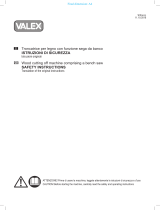 Valex 1390221 Manuale del proprietario
Valex 1390221 Manuale del proprietario
-
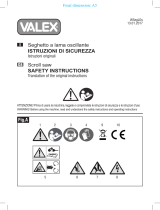 Valex 1410233 Manuale del proprietario
Valex 1410233 Manuale del proprietario
-
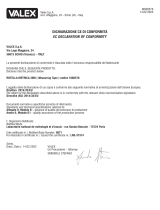 Valex 1800576 Manuale del proprietario
Valex 1800576 Manuale del proprietario
-
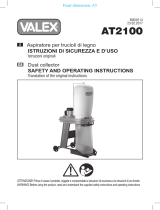 Valex 1350114 Manuale del proprietario
Valex 1350114 Manuale del proprietario
-
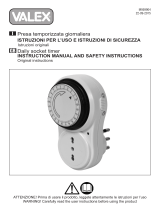 Valex 1959904 Manuale del proprietario
Valex 1959904 Manuale del proprietario
-
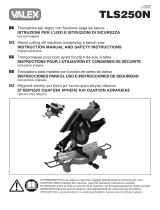 Valex 1390218 Manuale del proprietario
Valex 1390218 Manuale del proprietario
-
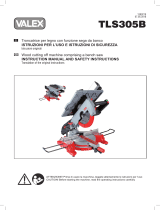 Valex 1390219 Manuale del proprietario
Valex 1390219 Manuale del proprietario
-
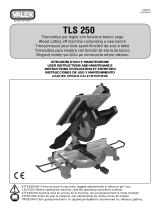 Valex 1390216 Manuale del proprietario
Valex 1390216 Manuale del proprietario
-
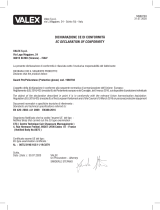 Valex 1960793 Manuale del proprietario
Valex 1960793 Manuale del proprietario
-
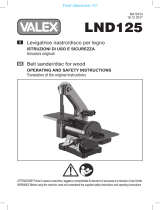 Valex 1410154 Manuale del proprietario
Valex 1410154 Manuale del proprietario

























